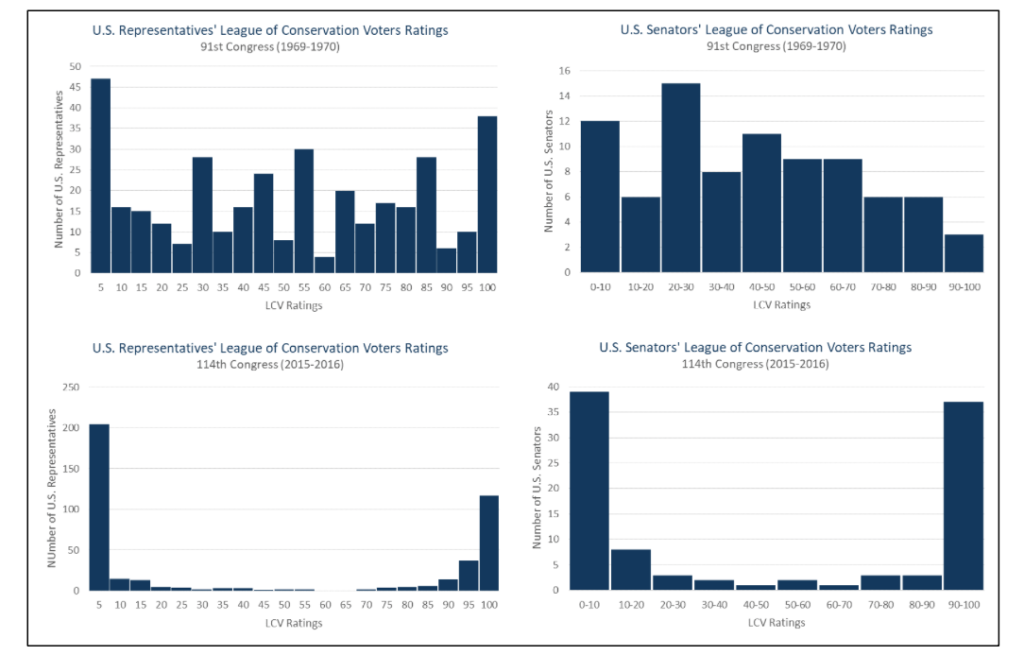In a new report published today by the Niskanen Center, political scientist David Karol analyzes how environmental issues have become increasingly partisan in American politics, and explores what might shift the debate on environmental issues—and climate specifically—into more productive territory. There are lessons here for anyone looking to affect climate policy on the right side of the aisle.
Before we can think about how to shift the lines of partisan battle, it is helpful to understand how the lines were drawn in the first place. Using scorecards from the League of Conservation Voters, Karol shows the stark difference between the mid-20th century (when modern environmentalism entered politics) and today. Forty-eight years ago, environmental scores were pretty evenly distributed in the House and the Senate. Today, the Congress is split into pro- and anti-environmental blocks comprised almost exclusively of Democrats (pro) and Republicans (anti). The near complete division in the 114th Congress is surprisingly stark.
Karol’s paper dives deeper into how that divergence grew steadily over time. The short story is that there was no event that dramatically shifted environmental stances between one Congress and the next. Instead, members of Congress were steadily sorted into pro- and anti-environmental stances along party lines, with declining influence from external factors like local constituencies and economic interests, party geography, and the personal backgrounds of the members themselves.
Karol explains that as politicians took increasingly partisan stances on the environment, their coalitional allies and voters took partisan cues and created more extreme positions.
Organized interests have become polarized as well. Endorsements and campaign contributions from environmental groups now overwhelmingly go to Democratic candidates, while economic sectors frequently at odds with environmentalists, including fossil fuel producers and much of agribusiness, increasingly support Republicans. Divisions between Republican and Democratic voters on the environment, while not as great as among political elites, have grown as well.
In the second part, Karol examines what might arrest or reverse the increasing partisanship around environmental issues, particularly on climate change. The key insight is that the solid coalitional dynamics that have created the decades-long partisan division are probably robust to some big external new threat. Even if a new issue of great salience were to arrive, it would need to be obliquely related to climate to break up today’s political allegiances and re-sort political stances on climate (or the environment generally).
The implication is that no impending storm (another Harvey, Sandy, or Katrina) will be what breaks partisanship on climate. Likewise, no unique framing of climate risk in terms of economic costs, national security, or public health will suddenly rearrange American political coalitions. The weight of these coalitions is too great for them to be disturbed.
Instead, change may come about by shifting the lines of partisan battle, in response to the demographic and industry trends shifting underneath Republicans’ feet. Karol goes through a familiar set of factors that might soften Republican opinion on climate and create space for political opportunity. Among them are the familiar idea that young voters are much more comfortable with environmental protection than older generations, and that while the size and scope of the fossil fuel industry recedes, the renewables industry is growing in Republican districts and increasing its political activity.
As long as political costs remain low, very little is likely to change. But given enough pressure, the same coalitional strength that holds members of Congress to partisan stances today could help them maintain the same coalitional allies while adopting reform positions in the future. That is because political coalitions are mutually binding.
Karol explains that “provided they keep some distance between themselves and the other party on the issue, elected officials can move significantly in substantive policy terms.” And in doing so, they won’t necessarily lose their coalitional allies because there might not be anywhere else to go. As Karol argues, as parties shift stances “[a] lobby often has the choice between unhappily supporting ‘their’ party, and abstaining or supporting a minor candidate—risking the election of those less favorable to their views.”
The last section of the paper looks at how recent signals in the House of Representatives might be revealing how the tectonic plates are shifting under Republicans’ feet. Savvy—or vulnerable—members will sense opportunity earlier, and move to establish recognition as leaders on the issue and drum up positive media attention. The rapid growth of the bipartisan climate solutions caucus is a key indicator that there is a desire to do just that.
Anticipating such a shift, some Republicans may take forward positions on environmental issues to gather a reputation for issue leadership and distinguishing media attention. The growth in the number of Republican members of the bipartisan Climate Solutions Caucus in the House of Representatives may indicate that Members of Congress are taking such enterprising actions. So while environmental groups allege that the the Climate Solutions Caucus is an advanced exercise in greenwashing because of its lack of immediate policy results, its long-term effects may very well create lasting champions.
The chief goal of climate advocates working on the Republican side of the aisle is to make sure that those politicians who are willing to take leading stances have smart policy proposals that they can use to amplify those shifting coalitional trends, distinguish themselves from Democrats, and create political opportunities for themselves. Without good ideas, those folks taking leadership stances are more likely to fizzle out than provide a beacon for their colleagues and coalition—which would then leave us with the status quo.
Image by chayka1270 from Pixabay
